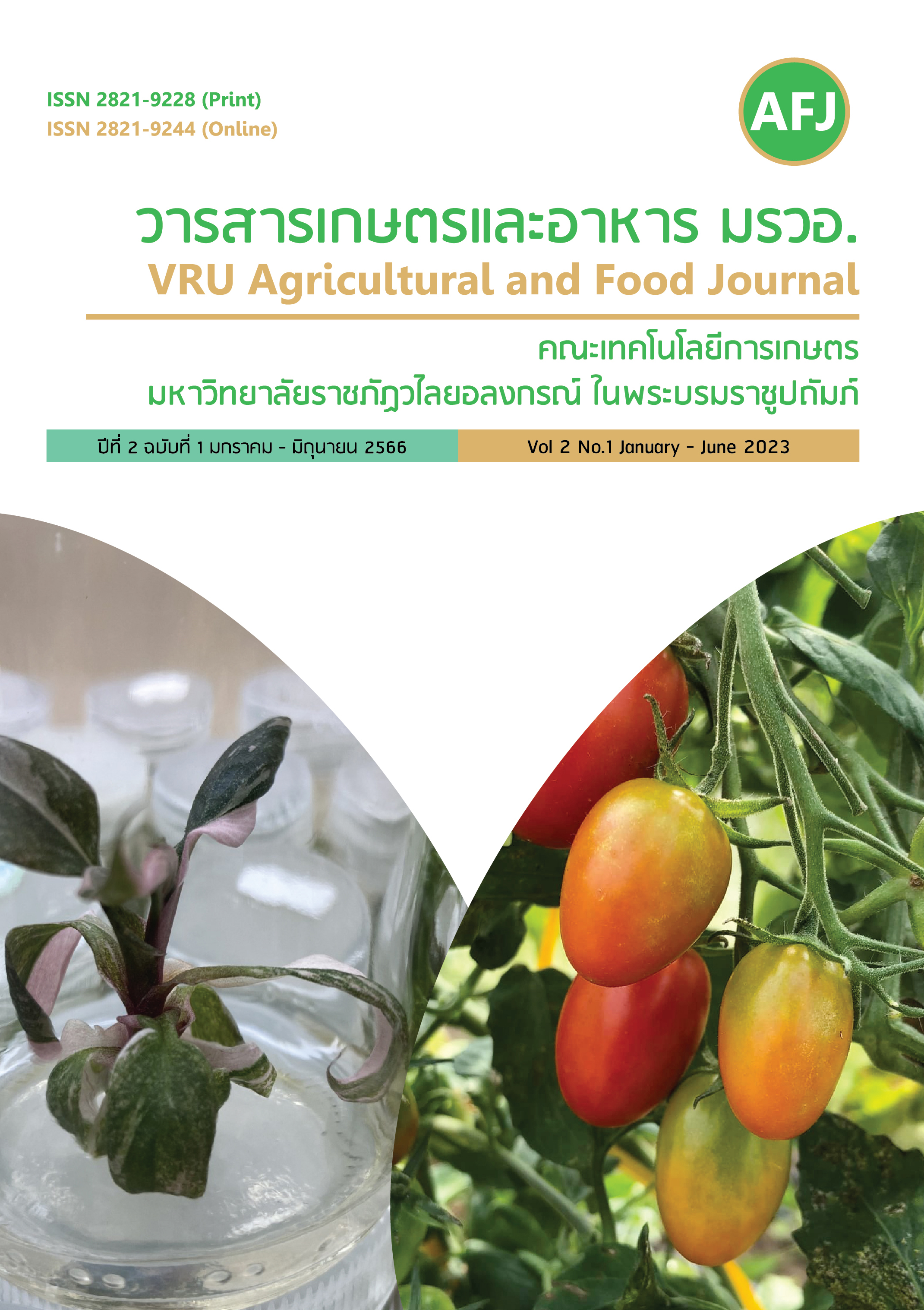Utilization of Mealworm Tenebrio molitor L. (Coleoptera: Tenebrionidae) Waste Process for the Possibility of Organic Marigold Production
Main Article Content
Abstract
Mealworm, Tenebrio molitor L. (Coleoptera: Tenebrionidae) is an important economic insect in southern Thailand. Waste of insects in farming process is frass or excrement which can be utilized and increased income for the farmers. The objectives of this research were to analyze plant nutrients of mealworm frass and feasibility study on the utilization of mealworm frass in the organic marigold production process. Results revealed plant nutrients were macronutrient and micronutrient. The primary macronutrients were nitrogen (N), phosphorus (P) and potassium (K) were 4.24, 4.86 and 2.27%, organic matter (OM) was 57.93 %, carbon to nitrogen (C/N) ratio was 9:1, electrical conductivity (EC) was 7.06 and pH was 5.71, respectively. The possibility of organic marigold production was compared with 4 marigold cultivation treatments; chemical fertilizers (T1), wheat bran weevil manure (T2), chicken manure (T3) and without chemical fertilizers (T4). This study was found that the first harvested marigolds flowers was on the 62nd day in mealworm frass treatment while the other treatments were on 66nd day after planting. The average number of flowers of chemical fertilizers (T1), wheat bran weevil manure (T2), chicken manure (T3) and control/no fertilizer application (T4) was 10.33±3.57, 10.17±1.74, 6.73±1.72, and 2.13±2.37 flowers per plant. Fresh flower weight was 9.37±3.64, 8.11±2.43, 7.48±1.81, and 4.75±1.05 g. per flower and flower diameter was 6.56±0.91, 6.11±0.54, 5.83±0.50, and 4.77±0.42 cm, respectively. Data analysis of average number of flowers, fresh flower weight and flower diameter of marigold on mealworm frass and chemical fertilizer were not significant different (P>0.05).
Article Details

This work is licensed under a Creative Commons Attribution-NonCommercial-NoDerivatives 4.0 International License.
This article is published under a Creative Commons Attribution-NonCommercial-NoDerivatives 4.0 International License (CC BY-NC-ND 4.0), which allows others to share the article with proper attribution to the authors and prohibits commercial use or modification. For any other reuse or republication, permission from the journal and the authors is required.References
Chaovapasee, K. 2013. Extimation of genetic parameters and breeding values for economic traits in mealworm (Tenebrio molitor L.). Princess of Naradhivas University Journal, 5(1): 61-68. (in Thai)
Houben, D., G. Daoulas, M. Faucon and A. Dulaurent. 2020. Potential use of mealworm frass as a fertilizer: impact on crop growth and soil properties. Scientific Reports, 10: 4659. 9 p.
Kunwanlee, K. and Maneerat, T. 2021. Comparison between mealworm (Tenebrio molitor L.) waste and chemical fertilizer on the growth and yield of selected-PSU green pepper. VRU Research and Development Journal Science and Technology, 16(1): 47-56. (in Thai)
Nattakit, P., N. Thanakornvises, N. Luengprapha, K. Boonwitian, and N. Srisuvor. 2021. Sensory characteristics of soybean breads and marigold (Tagestes erecta L.) breads. Research Journal Rajamangala University of Technology Thanyaburi, 20(1): 2651-2289. (in Thai)
Nogalska, A., S. W. Przemieniecki, S. J. Krzebietke, D. Zaluski, A. Kosewska, M. Skwierawska and S. Sienkiewicz. 2013. The effect of mealworm frass on the chemical and microbiological properties of horticultural peat in an incubation experiment. International Journal of Environmental Research and Public Health 20, 21. https://doi.org/10.3390/ijerph20010021.
Pibumrung, P. 2021. Effect of cricket frass and mealworm waste compost pellet applications on soil properties and yield of Pathum Thani 1 rice. Journal of Agricultural Research & Extension 39(1): 52-64.
Poveda J., A. Jimenez-Gomez, Z. Saati-Santamaria, R. Usategui-Martin R. Rivas and P. Garcia-Fraile. 2019. Mealworm frass as a potential biofertilizer and abiotic stress tolerance-inductor in plants. Applied Soil Ecology 142: 110-122.
Trade Policy and Strategy Office. 2022. Insect novel food: Value added agricultural products. Source: http://www.tpso.moc.go.th/th/node/11829.

